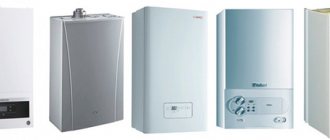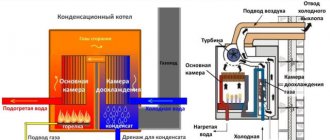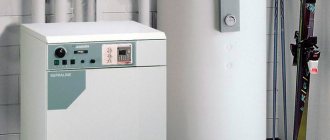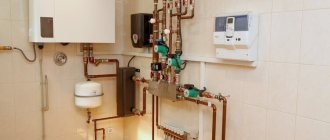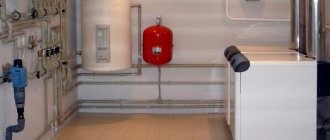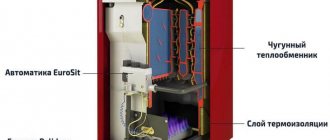Gas boilers are considered the most convenient and efficient sources of thermal energy.
Several design options have been developed that have remained virtually unchanged for many years.
Manufacturers create only certain variants of basic circuits based on the initially developed design.
All functions of the units are additions to the main type of gas boiler - a single-circuit floor-standing model designed to perform the main task.
Let's take a closer look at them.
Floor-standing single-circuit gas boilers and their features
The design of floor-standing single-circuit gas boilers is economical and simple.
They are capable of performing a single basic function - heating the coolant for the heating system . These units do not perform any additional tasks, therefore the set of units and parts of the unit is limited - only the most necessary elements are involved in the work.
In addition, the floor mounting method allows the use of durable and powerful units with increased weight and capabilities.
This makes the design more powerful and capable of high performance.
Most models are equipped with massive heat exchangers that have a high heat transfer capacity and can accommodate an increased volume of liquid. There are no restrictions on weight or dimensions for floor-standing boilers, so the power can be 100 kW or more.
Many units can be connected in a cascade (usually up to 4 units), creating a high-power thermal station.
Another feature of single-circuit floor-standing boilers is the ability to connect an external storage boiler.
This combination allows you to get not only heating of the house, but also a stable supply of hot water.
Most experts consider this option more preferable than using a double-circuit boiler, since the mode of supply of hot water from the boiler is smooth, without temperature jumps or pauses.
Power supply type: non-volatile or not
The principle of operation of a volatile boiler is as follows: the installed automation detects, using sensors, the activation of DHW equipment or a decrease in temperature in the heating circuit and turns on the heating.
The coolant, passing through the heat exchanger, is heated to the required temperature and supplied to the heating or hot water circuit using a circulation pump.
It is clear that a volatile device will consume electricity. To reduce its consumption, it is better to choose models with energy consumption class A++. But, in addition to energy consumption, it is also necessary to take into account the cost of repairs, replacement of spare parts, and automation.
For example, failure of electronic boards is a fairly common occurrence; repairs are expensive, and replacing a part with a new one will cost almost half the cost of the boiler itself.
Energy-dependent boilers are more technologically advanced, they maintain the temperature in a certain mode and save more gas.
But non-volatile models can be called the most adapted to conditions when the electricity is turned off, and energy fluctuations make you worry about the integrity of the automation.
Heating principle: flow or storage
The flow principle of heating can be carried out by two types of heat exchangers:
- separate;
- bithermic.
Both of them have advantages and disadvantages, so the choice can only depend on the buyer of the equipment and his preferences.
A boiler with a separate heat exchanger has a primary (intended for heating) and a secondary (used to heat water) heat exchanger. The secondary heat exchanger has a built-in circuit that serves to heat water, which is heated by taking heat from the heating circuit coolant.
This type of boiler cannot operate in heating and water heating modes at the same time: as soon as one system comes into operation, the operation of the second is suspended.
The disadvantage of flow-through double-circuit floor-standing boilers is the excessive consumption of cold water, which must drain before warm water begins to flow into the tap. In addition, when using water from two or more points at the same time, the pressure in the hot water system will be uneven, as will the temperature of the water in the taps (+)
In bithermal heat exchangers, the water is heated by a burner located in a tube that runs inside the main heat exchanger. In such equipment, water heats up much faster. Such boilers are more compact and cheaper.
A significant disadvantage of bithermic boilers is the temperature difference in the hot water supply. This leads to the fact that very hot water can flow immediately after opening the tap.
For those houses where consumption is not so high, the operation of double-circuit boilers is quite capable of providing the minimum needs for warm water. But if consumption is planned in large quantities, it is better to provide a more powerful option - a boiler with a boiler connection, in which a certain supply of hot water will accumulate (+)
Double-circuit floor-standing gas boilers with a built-in tank, unlike flow-through models, can provide water in full. The volume of tanks varies from 25 to 60 liters. To heat large volumes, devices with high power are used. You can increase productivity even further by using boilers combined in cascades.
Advantages and disadvantages
The advantages of floor-standing single-circuit boilers include::
- simplicity, absence of unnecessary components and parts;
- reliability, stability;
- high power, ability to heat large areas;
- the presence of powerful and efficient heat exchangers with a high heat transfer coefficient;
- the floor mounting method simplifies the installation and connection of the unit;
- management of single-circuit models is simple and accessible to all users;
- There is a large selection of designs that allow you to obtain the most suitable type of boiler for the given conditions.
The disadvantages of floor-standing single-circuit boilers are:
- lack of independent ability to supply hot water;
- the specifics of the work require the allocation of a special room - a boiler room, equipped with window and door openings;
- atmospheric or non-volatile models are connected to the central common house chimney, which determines the location of their installation;
- increased power automatically means increased fuel consumption.
NOTE!
Most floor-standing single-circuit boilers are used in private homes or public spaces, where it is possible to provide all the conditions for the normal operation of the unit. The use of these models in apartments is impractical, since the dimensions and specific features of floor-standing boilers are excessive in such conditions.
Operating principle
The operation of a single-circuit floor-standing gas boiler consists of flow-through heating of the coolant using thermal energy obtained from fuel combustion.
The liquid enters the heat exchanger, receives the maximum possible heating for a given operating mode and enters a three-way valve . This is a unit where the hot coolant is mixed in a given proportion with the colder return flow.
The more return is added, the lower the temperature of the liquid entering the heating circuit. This is how the room heating mode is adjusted. The coolant moves under the action of a circulation pump, and the air supply and smoke removal are controlled by a turbofan.
The operation of all components is under continuous monitoring of a self-diagnosis system - a network of sensors installed on important components and parts of the boiler.
If abnormal situations occur or any elements fail, the sensors signal to the electronic control board, which immediately generates an error signal.
Some types of malfunctions cause immediate shutdown and blocking of the boiler for safety purposes; the control unit simply notifies the user about minor malfunctions.
IMPORTANT!
All problems that arise must be resolved only by qualified specialists with appropriate clearance. Unauthorized interference with the boiler design is an administrative offense.
Which coolant is better for a cast iron heat exchanger - water or antifreeze?
Cast iron does not react with antifreeze, so it can be used as a coolant in a heat exchanger along with water. However, the following features of this liquid should be taken into account:
- Antifreeze is denser than water, so it will take longer to heat up, and therefore more fuel. If we add here the time for warming up the heat exchanger itself, then it can take from 10 to 25 minutes before heat is supplied to the room.
- Non-freezing liquid takes a long time to heat up, but it also gives off heat longer compared to water.
What are its advantages of energy-dependent species
Non-volatile installations operate only on a mechanical principle, without needing to be connected to the power supply system.
This makes them indispensable in remote villages, in areas with dilapidated or overloaded electrical networks . Frequent shutdowns cause the heating to stop working, which is unacceptable in the Russian winter.
Non-volatile models ensure continuous heating of the house regardless of external conditions. However, such possibilities limit the capabilities of non-volatile boilers. They work only on natural physical processes - circulation of the coolant requires installation of the heating circuit at a slight angle and is based on the rise of warm layers of liquid upward.
Smoke removal occurs under the influence of normal draft in the chimney. It must be taken into account that natural processes occur with minimal intensity and are unstable, so external additional devices are usually installed - a turbo nozzle and a circulation pump.
They make the unit more productive, and operation in non-volatile mode occurs only during a power outage.
If there is no power supply to the house at all, only the basic capabilities of the unit are used.
Kinds
There are several design options for floor-standing single-circuit boilers. They differ from each other in various ways.
By type of combustion chamber:
- atmospheric (open) . The air directly surrounding the boiler is used, and the smoke is removed under the influence of natural draft. Such models are connected only to the central vertical chimney;
- turbocharged (closed) . To supply air and remove smoke, a coaxial type chimney is used (pipe in pipe), or two separate pipelines that perform the functions of intake and supply of air to the boiler and exhaust of flue gases.
According to heat exchanger material:
- steel. The most common option used on inexpensive models.
- copper. The coil-shaped design increases the path of liquid passing through the heating zone. Such units are installed in expensive models from top manufacturers;
- cast iron. Installed on powerful and massive units. Cast iron heat exchangers demonstrate high performance, efficiency, and are capable of developing large units of power. Used for units from 40 kW and above.
By heat transfer method:
- convection Conventional heating of the coolant in the flame of a gas burner;
- parapet. They are able to do without a heating circuit, being a kind of analogue of a conventional stove;
- condensation The coolant is heated in two stages - first in the condensation chamber, from the heat from the condensing flue gases, and then in the usual way.
NOTE!
Condensing boilers are able to fully operate only with low-temperature systems (warm floors), or when the difference in temperature outside and indoors is no more than 20°. These conditions are not suitable for Russia.
How to properly install equipment
You can install such equipment either independently or with the help of boiler installation specialists. The only condition that cannot be violated is to include the boiler in the gas system itself, because such work will have to be entrusted to a specialist. Moreover, such people must have special permits and certificates. If the homeowner violates this provision, then first of all, he will be disconnected from the system, and secondly, a very large fine will be imposed. But in order to independently connect a cast-iron gas boiler, you will still need construction skills.
Cast iron boilers have an impressive weight, so if you buy a mounted boiler, then an impressive frame must be mounted under it. Such equipment must be installed in the boiler room.
And such technical premises have special requirements:
- The ceiling height in the boiler room must be at least 3 meters, and the room must be at least 4 square meters. meters. These parameters are suitable for an average-capacity boiler, but the larger the boiler, the more space there should be around. Usually such things are recommended by the manufacturer themselves;
- the presence of at least a single window, because there must be air flow. The door opening must be 80 cm wide and the gap between the floor and the door leaf must be at least 35 mm;
- the distance to electrical and gas installations or appliances must be at least 3.5 meters;
- On the floor, in the place where the cast iron boiler is planned to be installed, a cement screed is poured, and this place is reinforced with a steel plate. It is important to remember that the steel sheet must be located under the entire surface of the bottom of the heating installation, and also protrude 3-4 cm beyond its front side;
- With materials that have fire-resistant qualities, it is necessary to strengthen the entire part of the wall where the chimney pipe will pass.
You may be interested in >> What to do if the boiler blows out in the wind
The main document when independently preparing a boiler for mounting it into the system should be an accompanying document in the form of instructions developed by the manufacturer.
Such a document gives parameters and regulates the procedure for connecting the boiler to the main pipeline, to the chimney system, as well as to the return and supply systems.
Do you need a boiler?
The need to connect a boiler is dictated by the needs of the room and users
If the unit operates in a private house, then installing a boiler will allow you to organize the supply of hot water in sufficiently large volumes.
However, if there is a connection to a centralized water supply, purchasing an external boiler seems impractical.
The most popular manufacturers and their brief descriptions
The leading manufacturers of floor-standing single-circuit boilers are European companies, although domestic designs are optimal for Russian conditions.
The most famous companies are:
- Viessmann. A German company, one of the most famous and reliable companies producing thermal products;
- Protherm. A company from Slovakia that produces a wide range of heating boilers. ALL series are named after animals of different species;
- Buderus . “Daughter” of the world-famous concern Bosh, which fully characterizes the quality and reliability of the products;
- Vaillant. Another German company whose boilers are considered the highest quality and most reliable;
- Lemax. Russian manufacturer of energy-independent floor-standing gas boilers. When developing the project, all the features of working in difficult conditions were taken into account;
- Navien. Korean boilers that successfully combine high quality and affordable prices.
The list of manufacturers can be continued for a very long time. All currently operating companies care about the quality and reliability of their products, trying to surpass competitors and reach the maximum number of users.
Device design
The water heater device includes the following main elements:
- burner;
- gas fittings (filters, taps, fuses);
- heat exchanger;
- built-in circulation pump;
- membrane expansion tank;
- automation.
Heat exchanger
The main attention should be paid to the heat exchanger, which can be made of different materials, because the service life of the equipment depends on this. For example, wall-mounted gas boilers with a cast iron heat exchanger will last for many years. However, it is difficult to install such units due to their heavy weight.
Devices with a copper heat exchanger weigh much lighter, and their price is much lower. A steel heat exchanger has high heat transfer, but is susceptible to corrosion.
Rating of TOP 10 best models
| Place | Name | Price |
| TOP 5 best Russian floor-standing single-circuit boilers | ||
| 1 | Lemax Premium-20 | 25 000 ₽ |
| 2 | Lemax Premium-12.5 | 21 000 ₽ |
| 3 | Lemax Leader-35 | 53 000 ₽ |
| 4 | ZhMZ AOGV-17.4-3 Comfort N | 21 000 ₽ |
| 5 | Rostovgazoapparat AOGV | 20 000 ₽ |
| TOP 5 best foreign floor-standing single-circuit boilers | ||
| 1 | Protherm Wolf 16 KSO | 19 000 ₽ |
| 2 | BAXI SLIM 1.230 iN | 55 000 ₽ |
| 3 | MORA-TOP SA 20 G | 30 000 ₽ |
| 4 | MORA-TOP SA 60 | 25 000 ₽ |
| 5 | Protherm Bear 40 KLOM | 57 000 ₽ |
The best Russian floor-standing single-circuit boilers
Let's look at the most popular models of Russian floor-standing gas boilers:
Lemax Premium-20
Products of the plant of the same name from Taganrog. A non-volatile floor-standing boiler with a power of 20 kW is capable of heating a house of 200 square meters. m.
Its main characteristics:
- Efficiency - 90%;
- coolant temperature (max) - 90°;
- heating system pressure (max) - 3 Bar;
- fuel consumption - 2.4 m3/hour;
- dimensions - 556x961x470 mm;
- weight - 78 kg.
The high demand for Lemax boilers indicates the demand and positive attitude of users towards domestic heating units.
Lemax Premium-12.5
Another representative of the Taganrog plant, designed for work in relatively small spaces. With a power of 12.5 kW, this boiler can heat an area of 125 square meters. m., which is suitable for country houses or country houses.
Unit parameters:
- Efficiency - 90%;
- coolant temperature - 90°;
- heating system pressure (max) - 3 Bar;
- fuel consumption - 1.5 m3/hour;
- dimensions - 416x744x491 mm;
- weight - 60 kg.
The boiler is relatively small, but its capabilities allow you to get the maximum effect.
Lemax Leader-35
Powerful (35 kW) floor-standing boiler, capable of serving a house or public space of 350 square meters. m. The combustion chamber is open type, which requires connection to the central chimney.
Other parameters:
- Efficiency - 90%;
- coolant temperature - 95°;
- heating system pressure (max) - 4 Bar;
- fuel consumption - 4 m3/hour;
- dimensions - 600x856x520 mm;
- weight - 140 kg.
A special feature of this model is a cast iron heat exchanger, which provides high heat transfer and stable heating mode.
ZhMZ AOGV-17.4-3 Comfort N
Product of the Zhukovsky Mechanical Plant. Power 17.4 kW, which is designed to heat 140 sq. m. The non-volatile design makes the unit resistant to all changes in the situation.
Boiler parameters:
- Efficiency - 88%;
- coolant temperature - 90°;
- heating system pressure (max) - 1 Bar;
- fuel consumption - 1.87 m3/hour;
- dimensions - 420x1050x480 mm;
- weight - 49 kg.
If necessary, the boiler can be reconfigured to be powered by liquefied gas, which further increases its autonomy.
Rostovgazoapparat AOGV
A unit from the Rostov plant with a power of 11.6 kW. Designed for heating 125 sq. m. usable area.
Its operating parameters:
- Efficiency - 90%;
- coolant temperature - 95°;
- heating system pressure (max) - 1 Bar;
- fuel consumption - 1.18 m3/hour;
- dimensions - 410x865x410 mm;
- weight - 49 kg.
The unit differs from other models in its cylindrical shape, which looks somewhat old-fashioned. However, this does not affect the quality and parameters of the boiler in any way.
Materials
Modern heat exchangers are made from various materials. Many qualities of these parts, as well as their pros and cons, depend on this parameter. Let's take a closer look at what heat exchangers for gas boilers are usually made from.
Steel
Most often, heat exchangers made of steel are found in gas heating equipment. Their prevalence is explained by the affordable cost of steel and the ease of its processing. Steel parts have their own distinctive characteristics, for example, such a heat exchanger turns out to be quite plastic. In addition, such options have a long service life, which attracts many consumers.
It should be noted that the ductility of steel specimens plays one of the most important roles when it comes to contact of the exchanger with high temperatures. Thanks to this characteristic, cracks do not form on the constituent elements of the boiler when serious thermal stress forms in the inner part of the metal near the burner.
However, steel options have one serious drawback - they are susceptible to corrosion. Of course, the appearance of rust shortens the service life of the exchanger. In addition, it must be taken into account that defects of this kind can appear on both the inner and outer half of the device.
Another disadvantage of steel exchangers is their large size and weight. In addition, with such parts, gas consumption will increase. This happens because most modern manufacturers strive to achieve a high level of inertness and expand the volume of the internal cavities of the heat exchanger.
Cast iron
The second most popular heat exchanger is rightfully made of cast iron. This model differs from a steel model in that when it comes into contact with liquid, it does not become susceptible to corrosion. Thanks to this distinctive feature, we can safely talk about the durability of cast iron options.
However, we must not forget that cast iron exchangers require regular maintenance and careful attention. In addition, these options are distinguished by their fragility. If scale accumulates on a cast iron heat exchanger, heating in the system may become uneven, which will lead to cracking of the exchanger. In order to extend the service life of this element, it is necessary to carry out periodic washing. In most cases, if running water is used, then washing is done once a year. If antifreeze is used as a heat carrier, then such work will need to be carried out once every 2 years.
Copper
Copper specimens are practical and durable. They have more pros than cons. The following characteristic features inherent in such exchangers should be highlighted:
- copper parts are lightweight;
- differ in small dimensions;
- do not become covered with destructive rust;
- they need very little fuel to warm up well.
Thanks to such advantages, the copper heat exchanger is recognized as one of the most popular. However, it is expensive, so they do not buy it so often. In addition, such elements become less strong and reliable under heating conditions. Copper heat exchangers burn out very quickly and then fail.
Aluminum
Many branded models of gas boilers contain aluminum heat exchangers. This material is distinguished by high plasticity, so it can be used to make exchangers of any shape and complexity. In addition, you need to take into account the fact that the level of thermal conductivity of aluminum is 9 times higher than that of another popular raw material - stainless steel. Aluminum heat exchangers have a very modest weight. Thanks to such positive characteristics, we can safely talk about the practicality of such components, as well as their reliability and functionality.
Such devices are also good because they usually do not have any vulnerabilities. For example, in stainless steel structures there are welding seams, kinks and other similar areas. They are very vulnerable, so they endure significant loads during equipment operation. In aluminum versions there are simply no such problems. Aluminum parts have strong chemical resistance, which is excellent for condensation.
The best foreign floor-standing single-circuit boilers
Let's look at the most popular models from Western manufacturers:
Protherm Wolf 16 KSO
The brainchild of Slovak engineers, the Volk 16 KSO floor-standing boiler is designed for heating medium-sized private houses. With a power of 16 kW it can heat 160 sq. m.
Main characteristics:
- Efficiency - 92.5%;
- coolant temperature - 80°;
- heating system pressure (max) - 1 Bar;
- fuel consumption - 2.4 m3/hour;
- dimensions - 390x745x460 mm;
- weight - 46.5 kg.
The unit is non-volatile, which is not typical for European models - they prefer fully functional designs. In addition, it is equipped with a two-pass heat exchanger, which increases the performance of the unit.
BAXI SLIM 1.230 iN
Italian boiler from a famous European manufacturer. Its power is 22.1 kW, designed to operate in a room of 220 sq.m.
Boiler characteristics:
- Efficiency - 90.2%;
- coolant temperature - 85°;
- heating system pressure (max) - 3 Bar;
- fuel consumption - 2.59 m3/hour;
- dimensions - 350x850x600 mm;
- weight - 103 kg.
The heat exchanger of this boiler is made of ductile cast iron, the warranty period is 2 years.
MORA-TOP SA 20 G
Czech engineers offer users a 15 kW boiler capable of heating 150 square meters. m. area. A cast iron heat exchanger stabilizes the operation of the system and equalizes the temperature, eliminating sudden jumps.
Boiler parameters:
- Efficiency - 92%;
- coolant temperature - 85°;
- heating system pressure (max) - 3 Bar;
- fuel consumption - 1.6 m3/hour;
- dimensions - 365x845x525 mm;
- weight - 99 kg.
An additional advantage is the non-volatile design, which expands the capabilities of the unit in difficult conditions.
MORA-TOP SA 60
Another Czech boiler with a capacity of 49.9 kW. Suitable for heating a house of 500 square meters. m., as well as for public or commercial premises.
Unit characteristics:
- Efficiency - 92%;
- coolant temperature - 85°;
- heating system pressure (max) - 3 Bar;
- fuel consumption - 5.8 m3/hour;
- dimensions - 700x845x525 mm;
- weight - 208 kg.
The boiler is equipped with a cast iron heat exchanger consisting of 7 sections. Electronic controls provide constant control over the operating mode of the system.
Protherm Bear 40 KLOM
Slovak floor-standing unit with a power of 35 kW. Heating area - 350 sq. m.
- Efficiency - 90%;
- coolant temperature - 85°;
- heating system pressure (max) - 4 Bar;
- fuel consumption - 4.1 m3/hour;
- dimensions - 505x880x600 mm;
- weight - 130 kg.
The features of the boiler include the design of the heat exchanger - it is a cast iron two-pass unit of 5 sections.


